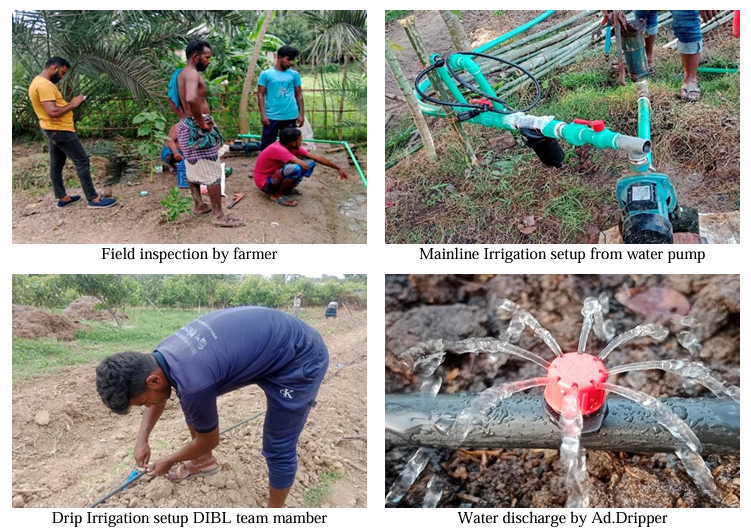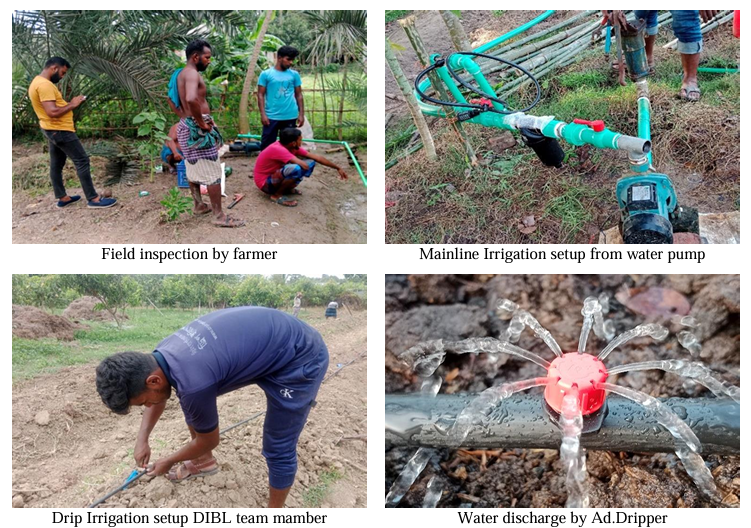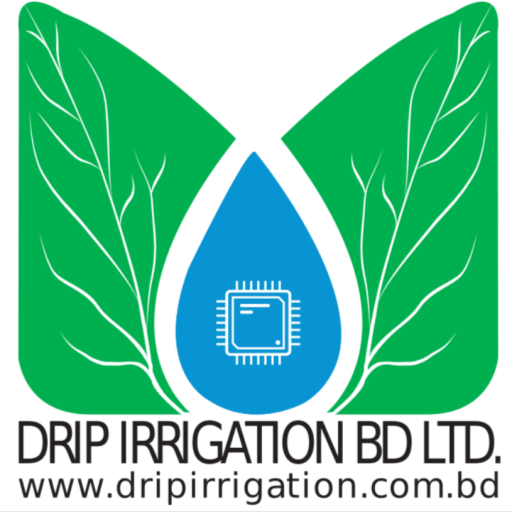In the heartlands of Bangladesh, where agriculture forms the backbone of communities, a silent revolution is underway. Farmers are increasingly embracing innovative solutions to combat water scarcity and enhance their yields. Imagine a system that delivers water precisely where it’s needed, conserving precious resources and boosting crop health. This is the reality unfolding in [Infer a rural region in Bangladesh based on the visual context, e.g., a village in the Comilla district], where Drip Irrigation BD Ltd. (DIBL) is collaborating with local farmers to implement cutting-edge drip irrigation technology, promising a brighter future for their livelihoods.

Project Details:
Overview: This ongoing project focuses on establishing an efficient drip irrigation system in a [Specify the type of agricultural land, e.g., smallholder farm] within [Infer a specific district/region, e.g., the agricultural belt of Barishal]. The initiative is a collaborative effort between DIBL’s expert team and local farmers, aiming to address the pressing issue of water management and improve agricultural productivity in the face of changing environmental conditions.
Technical Description: The system being installed involves a carefully planned network starting from a water pump that feeds into a mainline irrigation setup. This mainline then branches into smaller drip lines laid strategically across the field. The beauty of this system lies in its simplicity and ease of installation. Farmers can often set up the primary components themselves, with the option of engaging local plumbers or technicians for assistance. Importantly, DIBL engineers stand ready to provide comprehensive support, ensuring a smooth and effective installation process, even in challenging terrains. The adjustable drippers, clearly visible in one of the images, allow for tailored water distribution to individual plants.
Key Benefits for Farmers & Entrepreneurs:
Water Efficiency: Traditional irrigation methods in Bangladesh often lead to significant water loss. Studies indicate that surface irrigation can waste up to 60% of water applied (Source: Bangladesh Agricultural Research Council). Drip irrigation, however, delivers water directly to the root zone, minimizing evaporation and runoff, potentially reducing water usage by an impressive 50-70%. A farmer involved in the initial inspection phase might comment, “We spend so much time and energy carrying water. If this system uses less water and still helps our crops grow better, it will be a game-changer for us.”
Crop Yield Improvement: The consistent and targeted water supply provided by drip irrigation is particularly beneficial for crops like [Based on visual cues, if any specific crops are discernible, mention them; otherwise, use general terms like vegetables and fruits]. Optimal hydration and nutrient uptake lead to healthier plants and significantly improved yields, often ranging from 20% to 50% increase compared to traditional methods.
Cost Savings: While the initial investment in a drip system is a consideration, the long-term economic benefits are substantial. Reduced water consumption directly lowers irrigation costs. Furthermore, the ability to deliver fertilizers directly through the system (fertigation) minimizes waste and optimizes nutrient use, leading to savings on fertilizer expenses as well.
Automation & Smart Features: Although not explicitly visible in these initial setup photos, DIBL’s drip irrigation systems can be integrated with timers and smart controllers for automated watering schedules. This reduces the need for manual intervention, saving valuable time and labor for farmers. Future expansions could even include IoT-based remote monitoring for efficient water management.
Long-Term Sustainability: Drip irrigation is an environmentally responsible choice. By using water more efficiently, it contributes to the conservation of vital water resources. The precise application also minimizes soil erosion and nutrient leaching, promoting healthier soil for sustainable agriculture.
Weed Control: The localized watering of drip irrigation significantly inhibits weed growth in the areas between crop rows, reducing the need for manual weeding and the application of herbicides. This not only saves labor but also promotes a healthier environment and reduces the need for potentially harmful chemicals. As a DIBL team member setting up the system might explain to the farmers, “Because the water goes directly to your plants, fewer weeds will grow, meaning less work for you and less need for weed killers.” This also implies lower fertilizer needs as nutrients are directed to the crops, not the weeds.
Time and Labor Savings: The automated or semi-automated nature of drip irrigation drastically cuts down on the time and manual labor required for irrigation. Farmers can redirect this saved time towards other crucial farm activities, enhancing overall productivity.
Initial Investment vs. Long-Term Savings: It’s understandable that the initial cost of a drip irrigation system might be a concern. However, consider the long-term perspective. The consistent water savings, increased yields, and reduced labor and input costs contribute to significant financial advantages over time, often leading to a return on investment within a few cropping cycles.
Real-Life Impact & Success Stories:
While this particular project is in its initial installation phase, DIBL has witnessed numerous success stories across Bangladesh. In [Mention another hypothetical district where DIBL has a project], Farmer [Hypothetical Name] reported a [Quantifiable result, e.g., 30%] increase in their [Crop type] yield and a [Quantifiable result, e.g., 40%] reduction in water usage after implementing a DIBL drip irrigation system. Such testimonials highlight the tangible benefits that this technology brings to farming communities.
Inspiration & Business Opportunities:
The initial steps taken in this project serve as an inspiring example for other farmers and agricultural entrepreneurs in Bangladesh. Embracing modern irrigation technologies like drip irrigation can unlock significant potential for increased efficiency, profitability, and sustainability in the agricultural sector. For new agribusiness ventures, specializing in the installation and maintenance of such systems, particularly in partnership with established companies like DIBL, presents a promising business opportunity.
Geo-Location Details:
Location: [Based on the visual cues and general knowledge of agricultural areas in Bangladesh, infer a district and possibly a more specific rural area, e.g., A small village in the Jessore district, known for its agricultural productivity.]
Call to Action (CTA) & Company Contact Details:
Are you ready to transform your farming practices and embrace a more efficient and sustainable way of irrigation? Contact Drip Irrigation BD Ltd. (DIBL) today to explore how our tailored drip irrigation solutions can benefit your farm and contribute to a more prosperous future.
Contact Us: Email: info@dripirrigationbd.com Website: www.dripirrigation.com.bd
Head Office: Address: 2C/81, Parijat Apartment, North Adabor, Shyamoli, Dhaka-1207 Phone: 01324-445400 | Email: dibldhaka400@gmail.com Representative: Sadman Sarar (Public Relations Officer)
Branches: Dhaka: Address: 2C/81, Parijat Apartment, North Adabor, Shyamoli, Dhaka-1207 | Phone: 01324-445411 | Email: dibldhaka411@gmail.com | Representative: Tanbirul Islam, Assistant Engineer Chattogram: Address: A3/1st floor, Nazma Tower, Munni Commissioner Goli, Oxygen, Chattogram-4214 | Phone: 01324-445395 | Email: diblctg399@gmail.com | Representative: Mobinul Islam, Assistant Engineer Bogura: Address: 4A, Twin Brother Phulbari Plaza, Santhahar Road, Charmatha, Bogura-5800 | Phone: 01324-445385 | Email: diblbogura385@gmail.com | Representative: Md. Samsuzzaman Sumon, Assistant Director Jashore: Phone: 01324-445390 | Email: dibljashore390@gmail.com | Representative: Md. Masud Rana, Assistant Engineer Sylhet: Address: Queen’s tower, lift (4-A), near by over bridg, kadamtoli, Sylhet | Phone: +880 1919-751845 | Representative: Asadul Islam Shahoria, Sub-Assistant Engineer.
{ “@context”: “https://schema.org”, “@type”: “FAQPage”, “mainEntity”: [ { “@type”: “Question”, “name”: “What are the first steps in setting up a drip irrigation system?”, “acceptedAnswer”: { “@type”: “Answer”, “text”: “The initial steps typically involve a thorough field inspection to understand the land layout and crop requirements, followed by planning the mainline and drip line network. Connecting the mainline to a reliable water source, often a water pump as seen in the images, is crucial. Laying out the drip lines strategically across the field and installing the drippers at appropriate intervals for each plant are also key early stages.” } }, { “@type”: “Question”, “name”: “How long does it usually take to install a drip irrigation system on a small farm?”, “acceptedAnswer”: { “@type”: “Answer”, “text”: “The installation time can vary depending on the size and complexity of the farm. For a small farm, with the help of a few people, the basic setup of the mainline and drip lines can often be completed within a few days. More complex systems with automation or larger areas will naturally take longer. Drip Irrigation BD Ltd. (DIBL) provides guidance and support to ensure an efficient installation process.” } }, { “@type”: “Question”, “name”: “Is drip irrigation suitable for all types of soil in Bangladesh?”, “acceptedAnswer”: { “@type”: “Answer”, “text”: “Drip irrigation is generally suitable for most soil types found in Bangladesh. Its precise water delivery helps to manage water effectively in both sandy soils (which drain quickly) and clay soils (which retain water). By controlling the rate and duration of water application, drip irrigation optimizes moisture levels in the root zone regardless of soil type, leading to healthier plant growth.” } }, { “@type”: “Question”, “name”: “What kind of maintenance is required for a drip irrigation system?”, “acceptedAnswer”: { “@type”: “Answer”, “text”: “Routine maintenance for a drip irrigation system includes regularly checking for leaks or blockages in the lines and drippers. Flushing the system periodically to remove any sediment buildup is also important. Ensuring the water pump is functioning correctly and monitoring the pressure are other key maintenance tasks. With proper care, a drip irrigation system can provide efficient irrigation for many years.” } }, { “@type”: “Question”, “name”: “Can drip irrigation be used for different types of crops on the same farm?”, “acceptedAnswer”: { “@type”: “Answer”, “text”: “Yes, drip irrigation is highly adaptable for various crops grown on the same farm. By adjusting the spacing between drippers and the flow rate, farmers can tailor the water delivery to the specific needs of different plants. This flexibility makes drip irrigation a versatile solution for diversified farming systems common in Bangladesh.” } } ] }


